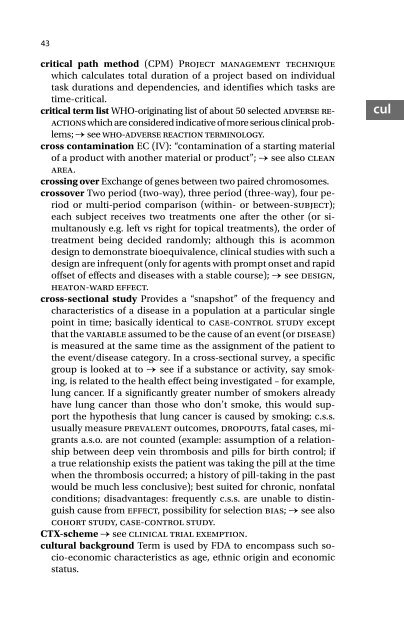220-Dictionary of Pharmaceutical Medicine, 2nd Edition-Gerhard Nahler Annette Mollet-3211898352-S
220-Dictionary of Pharmaceutical Medicine, 2nd Edition-Gerhard Nahler Annette Mollet-3211898352-S
220-Dictionary of Pharmaceutical Medicine, 2nd Edition-Gerhard Nahler Annette Mollet-3211898352-S
Create successful ePaper yourself
Turn your PDF publications into a flip-book with our unique Google optimized e-Paper software.
43critical path method (CPM) Project management techniquewhich calculates total duration <strong>of</strong> a project based on individualtask durations and dependencies, and identifies which tasks aretime-critical.critical term list WHO-originating list <strong>of</strong> about 50 selected adverse reactionswhich are considered indicative <strong>of</strong> more serious clinical problems;→ see who-adverse reaction terminology.cross contamination EC (IV): “contamination <strong>of</strong> a starting material<strong>of</strong> a product with another material or product”; → see also cleanarea.crossing over Exchange <strong>of</strong> genes between two paired chromosomes.crossover Two period (two-way), three period (three-way), four periodor multi-period comparison (within- or between-subject);each subject receives two treatments one after the other (or simultanouslye.g. left vs right for topical treatments), the order <strong>of</strong>treatment being decided randomly; although this is acommondesign to demonstrate bioequivalence, clinical studies with such adesign are infrequent (only for agents with prompt onset and rapid<strong>of</strong>fset <strong>of</strong> effects and diseases with a stable course); → see design,heaton-ward effect.cross-sectional study Provides a “snapshot” <strong>of</strong> the frequency andcharacteristics <strong>of</strong> a disease in a population at a particular singlepoint in time; basically identical to case-control study exceptthat the variable assumed to be the cause <strong>of</strong> an event (or disease)is measured at the same time as the assignment <strong>of</strong> the patient tothe event/disease category. In a cross-sectional survey, a specificgroup is looked at to → see if a substance or activity, say smoking,is related to the health effect being investigated – for example,lung cancer. If a significantly greater number <strong>of</strong> smokers alreadyhave lung cancer than those who don’t smoke, this would supportthe hypothesis that lung cancer is caused by smoking; c.s.s.usually measure prevalent outcomes, dropouts, fatal cases, migrantsa.s.o. are not counted (example: assumption <strong>of</strong> a relationshipbetween deep vein thrombosis and pills for birth control; ifa true relationship exists the patient was taking the pill at the timewhen the thrombosis occurred; a history <strong>of</strong> pill-taking in the pastwould be much less conclusive); best suited for chronic, nonfatalconditions; disadvantages: frequently c.s.s. are unable to distinguishcause from effect, possibility for selection bias; → see alsocohort study, case-control study.CTX-scheme → see clinical trial exemption.cultural background Term is used by FDA to encompass such socio-economiccharacteristics as age, ethnic origin and economicstatus.cul


